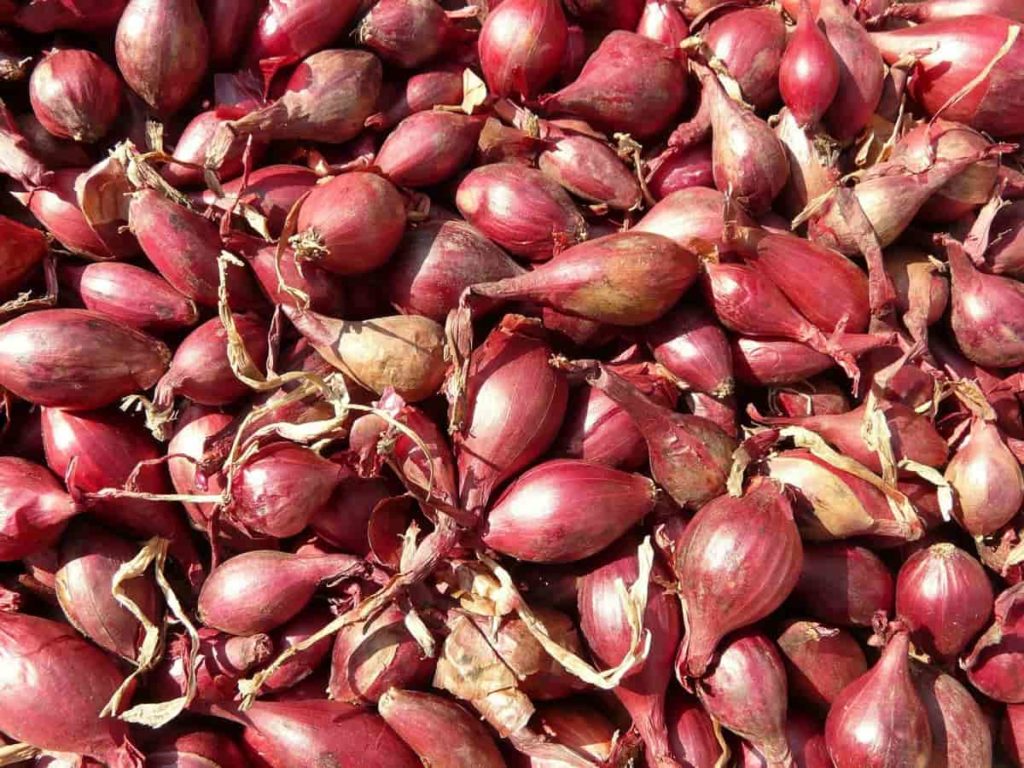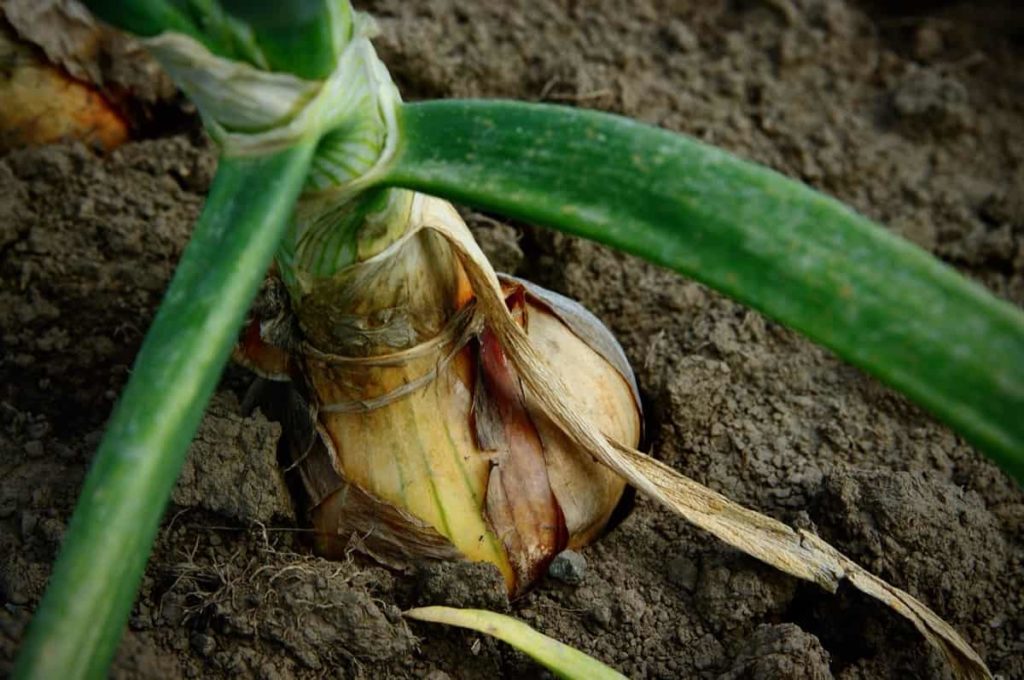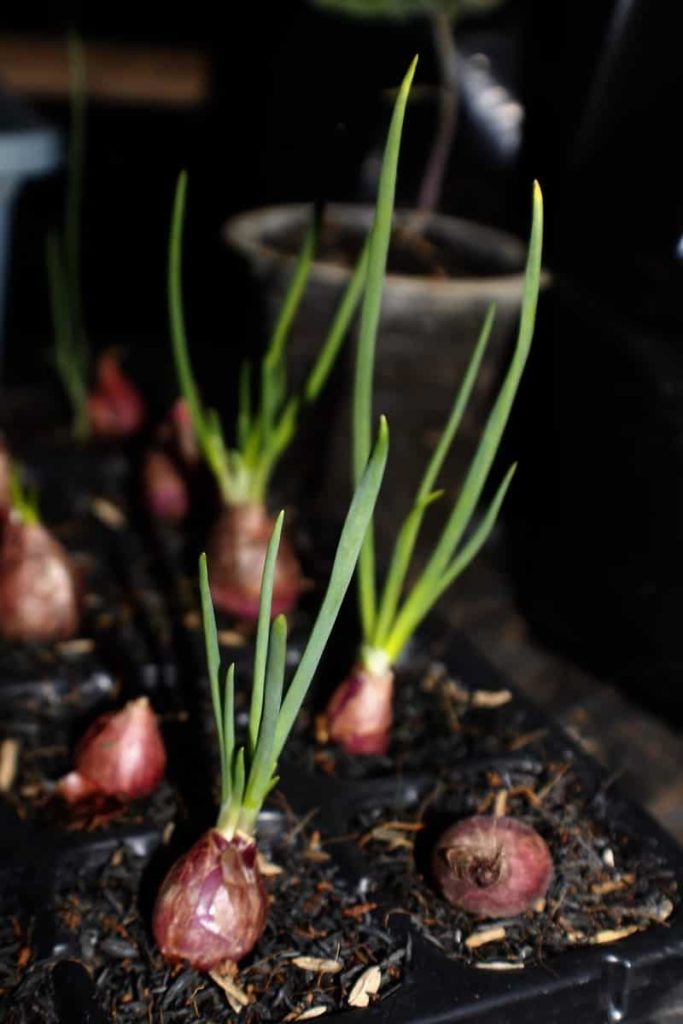Less caring and undemanding, the Shallot will produce a good crop in any well-drained, fertile soil in full sun. Shallots are tolerant and can be grown up in acidic soil but prefer 6.0 to 6.8 pH. The looser the soil composition, the more your Shallot grows. Shallots need to be grown in rich, sandy soil for good production. Sandy soil allows new emerging sets to spread and swell in fat bulbs, while heavy soil is less bound. Let’s check out the best fertilizer for Shallots below.

The Shallot will rot in wet soil, so if your soil is too rich and moist, you’d be better off growing them in raised beds or perhaps containers. Like garlic, the Shallots are heavy feeders and require available nutrients during their growth spurt. Don’t let the baby bulbs hungry. Instead, feed them several times throughout the growing period. The Shallots grow well when beds contain plenty of fertilizer and water kept weed-free.
Plants need water when growing; however, too much water (and fertilization) makes for soft shallots that are slow to mature. If the bulbs are too weak at harvesting, they will not store well. For Shallots, potassium and nitrogen play a vital role in photosynthesis; the growth plant at the initial level strengthens the stem and reduces production disorders. Fertilizer helps the soil to increase its fertility which boosts growth.
The quantity of fertilizer required depends on the total amount of nutrients extracted by the crop from the soil. To get maximum yield, each crop must have a predetermined amount of nutrients. It is compatible based on all fertilizer recommendations. Adequate nutrition is essential for satisfactory growth and production of crops.
Best fertilizer for Shallots
Organic fertilizers for Shallots
- Shallot leaves turning yellow usually appear in the middle of summer. Otherwise, it may be a lack of magnesium. Watering the solution of Epsom salt makes it easier to treat.
- Shallot requires a lot of nitrogen. Give plants an extra dose of liquid fish emulsion or other fertilizer about three weeks after planting; then continue to fertilize every 3 to 4 weeks. Stop feeding when the necks start feeling soft about four weeks before harvesting. If you use dry granular fertilizer, water it well.
- Cover with soil above the bulb, and strengthen with your hands to secure the Shallot bulbs in the soil. Water to moisten the soil to the depth of bulbs. Keep the soil moist until the green shoot appears in about a week. To conserve water and suppress weeds, mix around the base of your Shallot with organic mulch such as grass clippings or straw. In the fall or early spring, mulch Shallots with dry organic matter protect young seedlings from extreme cold and maintain moisture.
- Shallot does not usually require fertilizer. However, modifying soil with compost in spring can help add nutrients and improve drainage. Prepare your Shallot bed by tilling in compost (use compost that is completely aerobically broken and contains animal manures and plant residues instead of cedar or redwood). Chicken manure and its associated litter are higher in nitrogen, potassium, phosphorus, and calcium than other manures and are in organic matter.
- Like all onions, Shallot like rich soil in the sunny spot, but they don’t like too much acid soil, so check the pH and lime a couple of months before planting below 6.5 pH. You always put a handful, about 100 grams in metric, of standard fish emulsion, blood, and bone meal per square meter and a week before planting to carry them. Fertilize the growing Shallots either through side-dressing, work with each plant in a little fertilizer, or broadcast fertilizer throughout the bed. High nitrogen organic fertilizers such as blood meal or an artificial nitrogen source are excellent.
In case you missed it: Growing Shallots from Bulbs, Seed in Containers

Commercial fertilizers for Shallots
You should mix 1.3 kg of 10-10-10 per 100 square feet of soil before planting; side dress with 900 grams of 10-10-10 per 100 square feet twice during the growing season. The Shallot is very beneficial by being planted in soil that has been modified with rock phosphate and potash. You can dust the soil with nutrients before turning it to plant a Shallot set or dust the soil with nutrients after planting the Shallot sets.
Shallots fertilizer schedule
You will transplant Shallots to the garden about eight weeks after they grow, or when each plant is about five to six inches long with at least three long, spindly leaves. For transplant, choose a sunny spot with loose, well-drained soil modified with well-rotted manure or compost or mixed with balanced 10-10-10 (NPK) fertilizer as per package instructions. Shallots grow well in soil containing the remains of fertilizers used for previous crops in well-placed vegetable gardens. Avoid spreading fertilizer just before planting.
In case you missed it: Mint And Sage Companion Plants, Growing Tips

If organic fertilizers are applied to soil, wait for 5 to 6 months before planting the Shallots. Then, apply nitrogen-rich fertilizer to the bulbs planted in autumn and spring to boost them. Water well during dry spells. Shallots have maintenance needs that are like onions. To keep the soil moist, keep the garden regularly clean with weeds and water but avoid giving more water and allowing the soil to become too soggy, as it can cause the bulbs to rot.
When bulbs start growing, side dresses the Shallots with 10-10-10 fertilizer and sulfur and apply calcium nitrate about a month later. If flowers start to develop, cut them on the stems to prevent the Shallots from reproducing. You can fertilize plants with light, balanced fertilizers such as fish emulsion in the middle of the growing cycle. Do not give water or fertilizer during the last month of the cycle.
Withdrawal of water causes the stalks, which is essential for bulb growth. Feed nitrogen-rich fertilizer to the late winter Shallots, such as ammonia sulfate, at 35 grams per square meter. It not only increases growth but can also suppress premature flowers. Alternatively, use dry chicken manure. Shallots have shallow roots, so the hand weed between rows is good.
In case you missed it: Top 14 Lettuce Companion Plants, Planting Guide

How to fertilize Shallots in pots
The Shallots are well suited for container gardening. When grown in pots rather than outdoor beds, they thrive in full sunshine and dry soil conditions. Whether you plan to keep your Shallots containers indoors or outside, place the containers in a place with at least six hours of sunlight every day, and place them six inches inside each pot. If your Shallot container is large enough to grow plants, place them 10 inches apart.
Provide water when the soil dries up to a depth of 1 inch, slowly over the soil surface until they flow out of the drainage holes, then stop. Shallots usually require about 1 inch of water every week, but they may need water daily in hot, dry conditions. Feed the Shallots by fertilizing until the bulbs start to swell in early spring. Liquid 24-8-16 fertilizer products every week and dilute them at 1/2 teaspoon per 2 gallons of water. If using different fertilizer products, reduce it twice the manufacturer’s recommended rate.
Frequently asked questions about fertilizers for Shallots (FAQ)
Why is my Shallot so small?
Shallot can often be small for several reasons, including they have been planted too close and have not been given enough space to grow. You planted the bulb very deep in the soil. They are planted in soil that is not rich enough.
In case you missed it: Onion Companion Plants, Onion Planting Guide
How do you grow big Shallot?
Shallots are most grown from cloves. Place each clove in the soil with a thick end pointing downwards and above the soil line above. Plant them about 6 inches in rows, and make space at a distance of 12 inches in each row.
How often do you do water Shallots?
When the soil is 1-inch dry, water the Shallot plant. Slowly pour the water onto the soil surface until it drains out of the drainage holes and stops. Shallot usually requires about 1 inch of water every week, perhaps more in faster conditions. Fertilize container Shallot in early spring.
Can I grow Shallot in winter?
Depending on climate and growing variety, you can plant a Shallot at the end of autumn or winter. Autumn plantations tend to produce better if your climate is not too cold, or you can provide them with winter protection.
How deep are the roots of the Shallots?
It will help if you plant the Shallot about 2 inches deep. Plant garlic, onion, and Shallot are to plant them a ‘set’ deep, which means the depth of an onion set, Shallot sets, etc.
How long does Shallot take to grow?
It is usually about 90 to 120 days from planting. Each clove should yield more than ten Shallots. Gently dig the bulbs, loosen the soil with a speeding fork, then clean any dirt.
Do you distribute the Shallot before planting?
Before planting the Shallot, you will separate each bulb into individual cloves and peel the outer layer.
In case you missed it: Cheap Container Gardening Ideas, DIY, Tips, Secrets

Is it harder to grow a Shallot than onions?
Shallots, one of the members of the Onion family, Shallot not only matures quickly but requires less space than its counterparts. Therefore, it is very easy to grow a Shallot in your garden.
What happens if you don’t harvest the Shallot?
If allowed to grow long enough, you’ll develop a Shallot scape from the top leaves. They will continue to grow in flowers, which then produce seeds. If you want to harvest next year’s crop seeds, you can choose to let the scapes grow and bloom.
- Where to Place Indoor Plants in Your Home
- How to Grow Tomatoes Organically at Home: A Comprehensive Guide
- Organic Gardening on a Budget: Low-Cost Methods and Materials
- Gongura Seed Germination and Planting Methods
- Cabbage Seed Germination and Selection
- Broccoli Seed Germination and Selection
- Asparagus Seed Germination and Variety Selection
- Seasonal Flower Gardening: Best Practices for Spring, Summer, Fall, and Winter
- How to Grow Hibiscus from Flower
- Plantation Ideas for Home Decoration: A Beginners Guide
- Flower Garden Designs and Layouts for Beginners
- Planting and Spacing Techniques in Papaya: A Beginner’s Guide
- Growing Gold: Essential Techniques for Planting Pineapples
- How to Make Kalanchoe Plant Bushy: Home Remedies and Solutions
- 11 Reasons Why Your Gardenia is Not Blooming: Home Remedies and Solutions
- Eco Elegance: The Guide to Designing a Drought-Tolerant Landscape
- Gardening on a Slope: Strategies for Hillside Landscaping
- Nourish and Flourish: Top Organic Mulches for Thriving House Plants
- Everything You Want to Know about Indian Mogra Flower: Discover Uses and Growing
- Green Thumb Success: Expert Tips for Cultivating Greenhouse Pumpkins All Year Round
- Maximize Growth & Flavor: The Ultimate Guide to Companion Planting in Herb Gardens
- How to Control Rhododendron Problems Naturally: Home Remedies and Organic Ways to Fix Them
- Natural Magic: The Remarkable Benefits of Cinnamon for Plants
- Best Steps to Revive Dying Tulip with Natural and Organic Treatment
- 10 Reasons Why Your Angel Trumpet is Not Blooming: Remedies and Treatment
- How to Fix Periwinkle Leaf and Flower-Related Problems: Natural Remedies and Solutions
- How to Fix Zinnias Leaf and Flower Problems: Discover Natural and Home Remedies
- Organic Steps to Induce Lemon Tree Flowers: A Comprehensive Guide
- Bloom Booster: Crafting the Perfect Homemade Bougainvillea Fertilizer
- Optimizing Growth: A Guide to Applying NPK Fertilizer for Potted Plants
- 10 Best Homemade Fertilizers for Rubber Plant: DIY Recipes and Application Method
- How to Boost Female Pumpkin Flowers: Effective Steps for More Flowers and High Yields
- Transform Your Indoor Garden: Top Benefits of Pink Salt for Houseplants
- 10 Best Homemade Fertilizers for Peacock Plants (Calathea): Easy DIY Guide
- Unlock Blooms: 9 Reasons Why Your Potted Chrysanthemum is Not Blooming
- 8 Reasons Why Your Potted Hibiscus is Not Blooming: Fix it with Simple Solutions

Excellent details and to the point in simple lucid language. Keep up the good work.